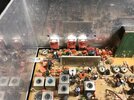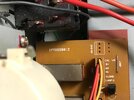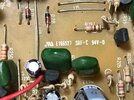Hello, found this forum while looking for info with the problem im having with an RCI2980. Stock radio, it has been working great but when i powered it up yesterday i heard a very faint "pop" sound now it has no transmit on am or ssb, the receive still works fine. All caps (all replaced 1yr ago) look good, dont see anything burnt up or odd looking. Not sure as to what i should be looking for, i have some knowledge and tools and could probably fix it if i new where to start, any and all help/support would be most appreciated, dont have a backup radio so im pretty much screwed for right now. TYIA
You are using an out of date browser. It may not display this or other websites correctly.
You should upgrade or use an alternative browser.
You should upgrade or use an alternative browser.
-
You can now help support WorldwideDX when you shop on Amazon at no additional cost to you! Simply follow this Shop on Amazon link first and a portion of any purchase is sent to WorldwideDX to help with site costs.
Help, RCI2980 No AM/SSB Transmit Problem.
- Thread starter RCIGuy
- Start date
When someone asks advice about some fault in a particular model car, the first question will be what production year it is. The internal details change a lot from year to year.
This radio model isn't quite that bad as a year-to-year thing, but it has been sold long enough for the transmitter's power circuits to have changed in a big way, especially since 2006-2007. If it's older than that it used conventional bipolar transistors in the transmitter's RF power stages. If it's newer than that, the radio was built to be lead-free. This means both lead-free solder and lead-free parts. The original RF power transistors used in the transmitter's power stages were discontinued by 2007, and the factory adopted a substitute called a IFR520 MOSFET. It just does the job but tends to be kinda fragile against high SWR. Yes, the older type transistors can fail, but they tolerate higher levels of stress.
The calibrated eyeball is your best first tool to see what the problem may be. Along the aluminum plate heat sink at the rear of the main circuit board you'll see the RF driver transistor at the far left, and the two "final", or main power amp transistors side-by-side to its right. With any luck yours don't look quite this bad.

The "pop" you heard is no doubt connected to your "no transmit" problem. The noise suggests that one part or another will appear physically damaged.
If you do find this kind of failure, there will also be other faults that are not so readily visible. What tools do you have for finding "hidden" failures in parts that look as if they are okay? A multimeter, wattmeter, dummy load are a big help. An oscilloscope is an unfair advantage.
73
This radio model isn't quite that bad as a year-to-year thing, but it has been sold long enough for the transmitter's power circuits to have changed in a big way, especially since 2006-2007. If it's older than that it used conventional bipolar transistors in the transmitter's RF power stages. If it's newer than that, the radio was built to be lead-free. This means both lead-free solder and lead-free parts. The original RF power transistors used in the transmitter's power stages were discontinued by 2007, and the factory adopted a substitute called a IFR520 MOSFET. It just does the job but tends to be kinda fragile against high SWR. Yes, the older type transistors can fail, but they tolerate higher levels of stress.
The calibrated eyeball is your best first tool to see what the problem may be. Along the aluminum plate heat sink at the rear of the main circuit board you'll see the RF driver transistor at the far left, and the two "final", or main power amp transistors side-by-side to its right. With any luck yours don't look quite this bad.

The "pop" you heard is no doubt connected to your "no transmit" problem. The noise suggests that one part or another will appear physically damaged.
If you do find this kind of failure, there will also be other faults that are not so readily visible. What tools do you have for finding "hidden" failures in parts that look as if they are okay? A multimeter, wattmeter, dummy load are a big help. An oscilloscope is an unfair advantage.
73
I looked at the finals and driver, no obvious damage to them, i would assume i would have to check voltage on the pin outs? The only numbers i could find were on the smaller board in front, left side and on right side of main board. I have all those tools you mentioned, as well as being handy with a soldering iron, scope is currently packed away. The pop noise sounded like it came more from the front right side of radio, i looked over the board carefully and did not see anything that looks damaged.






I did fail to mention one tool that can be helpful. Another radio tuned to the same channel with a coax jumper connected to it. Thread the shell back over the plug and the center pin becomes a half-inch long "sniffing" antenna. If you can't hear the transmit carrier from the Saturn this way, the power stages are probably off the hook, and the trouble is farther "upstream".
And if you can hear the radio's carrier on a monitor radio, checking for DC voltage on the "mirror" board is next. That's the small rectangle of circuit board held in three fork contacts in front of the driver and finals. Should be around 6 Volts DC there keyed down in AM mode. Should rise and fall as you turn the front-panel Power control. Should be around 13 Volts DC in sideband transmit.
73
And if you can hear the radio's carrier on a monitor radio, checking for DC voltage on the "mirror" board is next. That's the small rectangle of circuit board held in three fork contacts in front of the driver and finals. Should be around 6 Volts DC there keyed down in AM mode. Should rise and fall as you turn the front-panel Power control. Should be around 13 Volts DC in sideband transmit.
73
I checked voltage on mirror board, on am max voltage is 3.78 with power and mic gain wide open, does rise and fall, ssb voltage is 13.20. I reversed what you said about another radio on frequency, friend stopped over with another radio to test with. My rci is hooked to dummy load and other radio is about 25ft away connected to antenna, when i key the rci i can hear it on the other radio on am/ssb. Doesnt sound as loud as it should be, have to turn up the volume on other radio to hear the rci. Also put a watt meter inline and it shows about 4 watts am/ssb power and mic at max.
Checked the driver and pa bias, both are dead, zero mv on both.
Checked the driver and pa bias, both are dead, zero mv on both.
Last edited:
This is the info for the DX11B, but it uses the same board and is MOSTLY in the same configuration as your radio. There are some slight control differences, but the schematic should be close enough for you to get through the radio.I found the board #, its EPT360014B
Can anyone please help?

